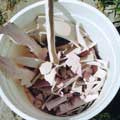Because there are variables beyond my control (clays, papers, water, mixing errors and etc) always pre test fire what you have before a big project. No guarantee can be offered that 'alternative" commercial paperclays now on the market will meet the all the performance advantages of my high performance trademark P'Clay® brand only available from licensed manufacturers/distributors.

FAQ more technical questions
Patch Slip Mixers: Have plenty of pulp inthe patch mixes. Vinegar in the patch paperclay slip mixes lends zero benefit o paperclay to paperclay joins. Those who understand and use paperclay only as a patch for traditional clay might someday explore what else is possible with it.
Still see some cracks at bone dry? This is almost always caused by insufficient pulp added to your base clay. Though you can patch withP'Slip® as a remedial measure, next batch be sure to "up" the pulp/clay ratio.
Long Term Storage: Dry small scraps out first. Store scraps of paper clay dried out in boxes or bags until ready to reconstitute in water.
To re-use just slake down in bucket of water in afew hours or overnight, pour off excess water and stir into a homogenous non lumpy slurry, .
Wall Thickness: The thicker the wall, say beyond 1-2 cm or 3/4 inch the higher the pulp content in the base recipe should be. In other words, dont go too thick with the stock blends of P'Clay®. However you can go super thick walls with ultra high pulp (as in 40% volume pulp to clay) I have gone up to 3 inches -7 cm (cubed volume) thick or more- and the fired result is ultra light. However: clay body maturity is a factor as is type of pulp you used, all these variables count.
Underfired Immature clay body?: If the fired result is too "soft," crumbly or immature, just fire hotter (ie a few cones higher) next time. Fire bisque at least to cone 04 not to cone 08 if you can. If you added too much paper then you get a real crumble near to "papier mache."
Eathenware paperclays rated at cone 04-05 can go alot hotter than normal and get very dense and hard by cone 4-6 even though the label doesnt say so. (test yours first).
Porcelains (high fire) vary: beware uneven kiln heat, sometime the temp has to come down a cone or so for some of these. We have successfully vitrified certain high pulp paperclay to have less that .01% water of absorbtion. Test, as all regions of the world have different raw materials. At temps above cone 6 behaviors vary slightly.
See Recipe for RuffRock GruffRock with perlite as a starting point for solid super thick casts. This area is only just beginning to be researched.
What are the differences between papier mache and other non kiln modeling medium compared to ceramic paperclay, p'clay®/p'slip®?
1. These type of products are very costly in comparison to P'Clays, used for the doll makers and other miniatures and beads.
2. These media have glues in them and other stabilizers, plastics, polymers and more. Some even have so callled pulverized "precious metal" in them. Most fire to a dust or crumble because of high pulp content and so little clay. These are not compatible with glaze and or they turn metallic black in the fire. The plastic polymers may make toxic fumes in fire too.